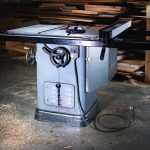We may receive a commission when you use our affiliate links. However, this does not impact our recommendations.
A jig is, by definition, a problem-solving device. As such, it shouldn’t take more time to make the jig than it would to perform the operation without it. If the purpose of the jig is to replace an operation that requires a lot of skill, how can you make the jig if you lack the skills? There is no shortage of published jigs that fail miserably on the above points. I think there may be woodworkers out there whose hobby is limited to building jigs, but for the rest of us, here is a simple method for making a jig to cut a square hole. In this case, I’m making the through-mortises in the case sides of a Stickley music cabinet.

I cut a piece of 1/2″-thick plywood to the width of the case side, and long enough to include the through-mortises at the top and bottom, as well as the shape of a cutout at the bottom (the pencil lines at the left) and a rounded drop at the front of the cabinet (the pencil lines at the right). I also cut some strips a couple inches wide to support the router, and some 1/2″ wide, which is the width of the finished mortise. You can see my layout lines for the mortises on the right side.

I’ve taken some double-sides tape, and covered the layout lines so I can stick the small plywood pieces to the large piece. The quality of double-sides tape can vary, I like to use Speed Tape which is strong enough to be a permanent adhesive. I place the plywood strips around the layout lines for the mortises. This is easy to do and it saves me from cutting a square hole in the plywood.

When I’m finished, I take a dead-blow hammer and tap on the strips to set the adhesive on the tape. Now I’m ready to take a router with a flush-trimming bit and make the cut outs for the mortises, after I drill a 3/8″-diameter hole in the middle of each opening that allows the router bit to pass through.

I put some blocks on top of my bench, flip the plywood over and proceed to rout the openings. The bearing on the bit follows the little pieces of plywood and makes the cut right on my layout lines. The bit leaves the corners rounded, but I’ve accomplished my goal; I have nice straight edges that are square to each other and the exact size I want.

I don’t need the strips anymore, so I pop them off. There are circumstances where I might want to have the jig a full 1″ thick. In that case I would hold the strips down with yellow glue and leave them on permanently. The extra thickness can help guide a chisel for squaring the corners. I don’t care for that method, even though it makes a good chiseling jig. The downside is you can’t see inside on a narrow mortise and you have to chisel the corners of the plywood square.

I just leave the corners of the jig round. I lay out the mortise locations on the solid-wood case side, and mark them with a knife. The knife cuts will guide my chisel when I trim, and prevent the router bit from tearing out around the line. This jig was quick to make, I didn’t have to do a lot of fussy cutting to make it, and it allowed me to make eight through-mortises in a short period of time. Here is the end result:
Looking for More Free Woodworking Information?
– Sign up for our newsletters to get free plans, techniques and reviews HERE.
– Like tools? We do! Read our latest tool coverage HERE.
– Looking for free project plans? We have hundreds. Click HERE.
– Learn a new woodworking technique today. Click HERE.
Here are some supplies and tools we find essential in our everyday work around the shop. We may receive a commission from sales referred by our links; however, we have carefully selected these products for their usefulness and quality.









Hi Rob,
Yes, the "Speed Tape" is clear, and it is really strong. So strong that a person could have trouble disassembling parts.
https://www.popularwoodworking.com/articleindex/the-wood-whisperer-a-sticky-situation
Bob, Quick question. Is that brand of double sided tape clear? Mine is white, so I was a little confused when you said that you "covered the layout lines".
Thanks for the article.
Rob
Another great tip which’ll bail me out some time down the line.
Thanks again Bob.